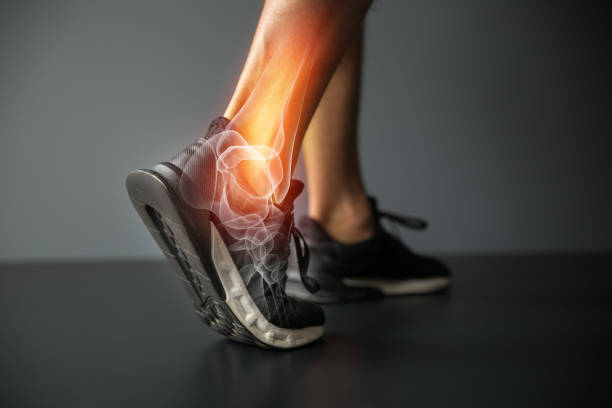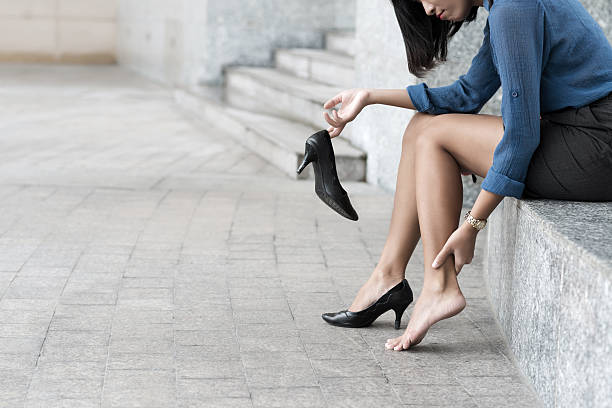Why Does My Ankle Hurt When I Walk: Common Reasons & Tips To Prevent

Many of us rely on walking as one of our most basic modes of transportation to get from point A to point B. Because of this, there aren’t many annoyances more annoying than the pain that makes it hard to move, especially foot or ankle pain.
You are not alone if your foot or ankle hurts. Up to 77% of American adults have experienced ankle or foot pain at some point in their lives, according to a study by the American Podiatric Medical Association (APMA).
While foot pain in general can be crippling, ankle pain in particular frequently interferes with a person’s ability to walk normally, which can negatively affect their ability to earn a living. You can learn more about ankle pain, including how to treat it and avoid it, by reading the information below.
Table of Contents
What is Ankle Pain
There are numerous factors that can contribute to foot and ankle pain. According to David Garras, MD, a foot and ankle orthopedic surgeon with Midwest Orthopaedics Consultants in Chicago, some of the most typical foot and ankle injuries are a sprained ankle brought on by physical activity, and plantar fasciitis, an inflammation of the ligament that connects the heel bone to the toes.
However, it can occur anywhere between the heel and the toes. Plantar fasciitis typically manifests as heel pain.
Tendinitis is another condition that can result in pain when walking around the ankle or foot. Ankle and foot pain can even be a symptom of certain medical conditions, such as arthritis.
Although ankle pain is a fairly common ailment, it is not the norm and should not be something you have to live with. In order to prevent any extended damage to your joints, it is crucial to see a healthcare professional or orthopedic doctor who specializes in the foot and ankle as soon as possible.
Common Causes of Ankle Pain
Gout
One form of arthritis is gout. It happens when uric acid doesn’t break down into your blood as it should. Instead, it forms crystals, builds up in your joints, and hurts. Ankle, heel, and other joints may also experience pain at the same time as your big toe at first.
Osteoarthritis
The most prevalent type of arthritis is osteoarthritis. It results from the cartilage in your joints breaks down. If you’re older, overweight, or have already suffered an ankle injury, this may be the source of your discomfort.
Peripheral Neuropathy
Walking can make your ankles hurt if your peripheral nerves are damaged. Tumors, injuries, diseases, infections, or infections can all cause nerve damage.
Bruising
You might experience discomfort when walking if your ankle has been severely bruised, such as from a hit or kick. This kind of trauma usually results in two to three weeks of pain before it subsides.
Sprain Or Strain
Sprains and strains result from damage to your ankle’s softer tissues. A strained ligament or tendon may be the cause of this. A sprain or strain typically recovers within a few weeks.
Fractures Or Breaks
You’ll probably experience severe pain when walking if a bone is broken or fractured. Swelling, redness, or numbness in the toes are frequently associated with breaks. Ankle breaks typically need medical attention and can take weeks or months to heal completely. Breaks can also pave the way for arthritis in later life.

Tips to Avoid Ankle Pain
Invest in Quality Footwear
It’s important to wear the right footwear if you hike or walk a lot for exercise or fun. Your performance can be enhanced by wearing shoes that fit properly and are well-made, in addition to preventing injuries.
When patients engage in activities without the appropriate gear, especially when it comes to shoes, many injuries and issues develop. It’s important to wear high-top hiking boots when hiking, appropriate running shoes when jogging or running, and ankle taping or bracing when playing cutting sports like tennis if there is any ankle instability.
Additionally, we advise changing shoes every six to twelve months. Checking the wear and ensuring they are still in good condition for the activity you are engaged in is equally important.
Skip the High Heels
High heels should only be worn occasionally or avoided altogether. In an effort to keep you standing and walking, heels can cause the ankle muscles to contract.
Over time, as the muscles grow accustomed to this, they start to weaken, which can result in ankle instability, which can worsen over time to cause nerve damage as well as leg and back pain.

Stretch Often
Your Achilles tendon is possibly the culprit behind the pain in your ankle. Your ankle’s back contains this tendon.
Due to its size and strength, it can overwhelm the smaller tendons in your foot and ankle, causing severe tendinitis and ankle pain. It is also the largest and strongest tendon in your body. Standing on the edge of the stair with your foot halfway up, your knees locked straight, and then lowering your heel below the stair is the simplest and easiest way to stretch your Achilles.
When doing this, we recommend holding onto something for balance. we suggest 10 reps held for 20 seconds each repeated a few times every day.
Strengthen the Muscles Around Your Ankle
Dr. tries to avoid strains and sprains. Garras advises building up the muscles around your ankle to train it to react. The simplest way to do this is to balance like a flamingo while standing on one leg.
At least 10 to 15 seconds should be spent standing on one leg. Throughout the day, alternate the legs. After you become adept at that exercise, push yourself further by standing on a pillow or a towel that has been rolled up.
Squatting while supporting yourself on one leg is another exercise we advise for building ankle muscles. Keep close to a wall for support if you feel off balance.
To avoid injury and ankle pain, always adjust your legs to balance strength and stability.
Seek Early Treatment When in Pain
Don’t attempt to endure ankle pain if you are experiencing it. The sooner you see an orthopedic foot and ankle specialist for an evaluation, the sooner you can relax knowing you’re not doing any more damage.
The majority of foot and ankle issues are easier to treat if they are addressed quickly rather than waiting weeks or months.
When to See a Doctor
Fortunately, most ankle and foot pain is transient and disappears on its own, particularly once the physical activity that triggered it stops. Ankle pain that worsens with minimal activity or that is persistent and does not go away with rest can be problematic.
Consult a doctor or orthopedic surgeon who specializes in foot and ankle issues if your ankle pain has persisted for more than 3 days without getting better despite your efforts to rest, apply ice, and take anti-inflammatory medications.
Close Note: Keep Exercise
Although ankle pain is common, you shouldn’t have to put up with it. There are many exercises you can perform at home to help strengthen the muscles in your ankles, as well as tools and remedies you can use at home to relieve pain and discomfort.
It is a good idea to seek a consultation with an orthopedic surgeon who specializes in foot and ankle injuries if you have chronic ankle pain that doesn’t go away with rest, exercise, and pain medication to see if further treatment may be required.
Tags: Ankle Hurt